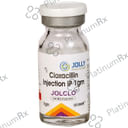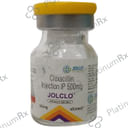Cloxacillin
Uses
Cloxacillin is used in the treatment of bacterial infections.
How it Works
How Cloxacillin works Cloxacillin is an antibiotic that kills bacteria by preventing them from forming their protective covering, known as the cell wall, which is essential for their survival.
Side Effects
Common side effects of Cloxacillin include rash, injection site reactions (pain, swelling, redness), vomiting, allergic reactions, nausea, and diarrhea.
Expert Advice
- You have been prescribed Cloxacillin for the treatment of bacterial infections.
- It is administered through an injection into a vein or muscle, or via a drip into a vein.
- Complete the prescribed course, even if you start to feel better.
- Stopping the medication early may cause the infection to return and become harder to treat.
- Diarrhea may occur as a side effect but should resolve once your course is complete.
- Inform your doctor if diarrhea persists or if you notice blood in your stools.
- Contact your doctor immediately if you develop an itchy rash, swelling of the face, throat, or tongue, or experience breathing difficulties while taking this medication.
Other Combinations
Amoxycillin + Cloxacillin
Amoxycillin + Cloxacillin + Lactic Acid (Lactobacillus)
Amoxycillin + Dicloxacillin
Ampicillin + Cloxacillin
Ampicillin + Dicloxacillin
Cefixime + Cloxacillin
Cefixime + Dicloxacillin
Cefpodoxime Proxetil + Dicloxacillin
Cefpodoxime Proxetil + Cloxacillin + Lactic Acid (Lactobacillus)
Cefpodoxime Proxetil + Dicloxacillin + Lactic Acid (Lactobacillus)
Ampicillin + Cloxacillin + Lactic Acid (Lactobacillus)
Ampicillin + Dicloxacillin + Lactic Acid (Lactobacillus)
Amoxycillin + Cloxacillin + Lactic Acid (Lactobacillus) + Serratiopeptidase
Amoxycillin + Cloxacillin + Probenecid
Amoxycillin + Cloxacillin + Serratiopeptidase
Amoxycillin + Dicloxacillin + Lactic Acid (Lactobacillus)
Amoxycillin + Dicloxacillin + Serratiopeptidase
Cefixime + Cloxacillin + Lactic Acid (Lactobacillus)
Dicloxacillin
Cefixime + Dicloxacillin + Lactic Acid (Lactobacillus)
Flucloxacillin Sodium
Related Medications
Cloxacillin 1000mg

₹110
Cloxacillin 250mg

₹18
Cloxacillin 250mg

₹179
Cloxacillin 250mg

₹4.5
Cloxacillin 250mg

₹20
Cloxacillin 125mg

₹12.8
Cloxacillin 500mg

₹8.2
Cloxacillin 500mg

₹45
Cloxacillin 500mg

₹26.4
Cloxacillin 250mg

₹7.2
Cloxacillin 625mg

₹120
Cloxacillin 500mg

₹60.4
Cloxacillin 500mg

₹9.4
Cloxacillin 500mg

₹11
Cloxacillin 250mg

₹13
Cloxacillin 250mg

₹14
Cloxacillin 250mg

₹29.5
Cloxacillin 250mg

₹23
Cloxacillin 500mg

₹70
Cloxacillin 500mg

₹10.6
Cloxacillin 500mg

₹40
Cloxacillin 500mg

₹8.4
Cloxacillin 500mg

₹26.4
Cloxacillin 250mg

₹15.1
Ampicillin 500mg + Cloxacillin

₹14.4